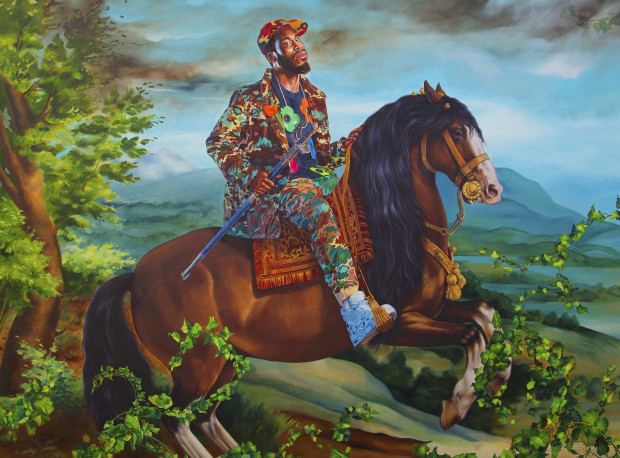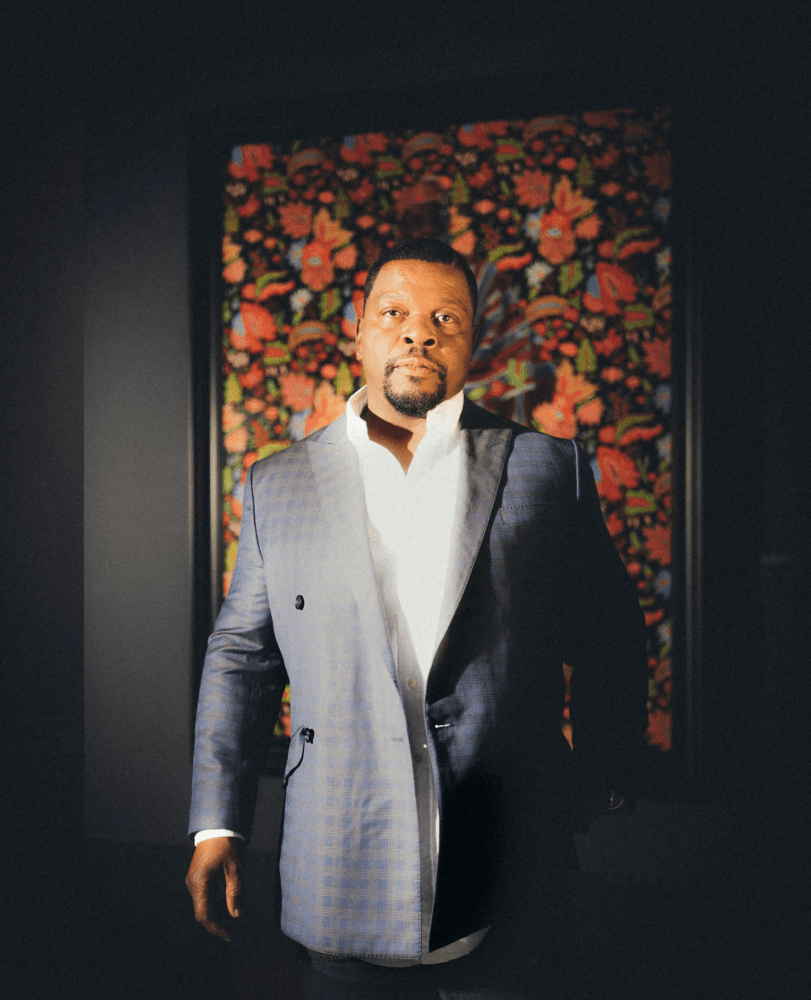

By Dionne Searcey
The American artist Kehinde Wiley shot to fame in 2018 with his unconventional presidential portrait, at least as far as U.S. presidential portraiture goes: Barack Obama seated amid a brightly colored, flowery background. Now, Mr. Wiley is again breaking the mold with a series of portraits of 11 current and former African presidents in an exhibition that opened Monday in Paris.
The Democratic Republic of Congo’s president, Félix Tshisekedi, poses with the cityscape of Kinshasa peeking out between curtains in the background. Macky Sall, Senegal’s president, holds a large staff and stands along a rocky shore, the national flag draped behind him. Former Madagascar President Hery Rajaonarimampianina is on horseback. Ghanaian President Nana Akufo-Addo wears brightly colored traditional clothing, exposing a bare shoulder.
“I’m trying to look at the African presidency in images, because there is no tradition of it,” Mr. Wiley says as he narrates a video that accompanies the exhibition, showing him dabbing the nose of Mr. Akufo-Addo’s portrait as solemn background music plays. “There is no history surrounding it. The history surrounds Western European cultural hegemony and domination.”
The exhibition, A Maze of Power, at the Musée du Quai Branly—Jacques Chirac in Paris, opens as anti-French sentiment is sweeping across Africa’s Sahel, where presidents deemed as being too close to their former French colonial overlords have been ousted in coups. One president in Wiley’s exhibition, Alpha Condé of Guinea, was himself removed in a coup in 2021. Another subject, Olusegun Obasanjo, first became Nigeria’s leader after a military coup in the 1970s but later was democratically elected as president.
Some of Mr. Wiley’s subjects may raise eyebrows for their human rights track records; Mr. Obansanjo and Mr. Condé, as well as other subjects of the paintings, presided over violent crackdowns on demonstrators in their respective countries.
Mr. Wiley deliberately chose not to discuss politics with his presidential subjects. Rather, he showed them a book of aristocratic, royal and military portraits from the 17th to 19th centuries, talking to them about “a vocabulary of power that each one of the presidents could choose to work with, or choose to ignore,” Mr. Wiley said in his film.
“Each head of state had the opportunity to engage the question of how they fit in that narrative,” he said.
Mr. Wiley’s selection as the artist for Mr. Obama’s portrait was surprising, because until then he had been known for his depictions of regular people. He has often returned to that subject since — until this latest choice to depict presidents.
For their sessions, the African presidents selected their own outfits and were asked to choose a space that is in keeping with the history of portraiture. Mr. Tshisekedi, for instance, sat in a grand, lavishly decorated hall he often uses as a waiting room for his guests.
In a text message sent through a spokesman, Senegal’s president, Mr. Sall, called being chosen by Mr. Wiley “a pleasant surprise and a source of personal pride.” He noted Mr. Wiley’s ties to Dakar, Senegal’s capital, which is home to the artist’s Black Rock studio and also to his show during Dakar’s art biennale in 2022.
The portrait, Mr. Sall said, is a reference to Moses crossing the Red Sea, leading the Hebrews to the Promised Land.
“I have strived to lead my people to the promised land of ‘emergence,’” he said, referring to one of his programs to provide Senegal with new infrastructure and other projects.
At home, a recent jail sentence for one of Mr. Sall’s political opponents has prompted some of the worst outbreaks of violent protest in the nation’s post-colonial history.
Some of Mr. Wiley’s paintings are reminiscent of his portrayal of Mr. Obama. For instance, Mr. Obasanjo, the former president of Nigeria, his golden ring sparkling from the linen canvas, is almost consumed by his background of brightly colored flowers.
The Obama portrait is so popular it has toured the nation, bringing out crowds of supporters to view it in person. The African presidents’ portraits are bound to be received differently. For starters, they are being exhibited in France, a former colonial powerhouse on the continent that, along with other Western nations, has come under increasing scrutiny for its role in looting African art, among other transgressions. Mr. Wiley has plans in the works for an African tour of his show. In the meantime, each president has requested a private viewing.
“This is not a celebration of individual leaders,” Mr. Wiley said in his film. “This is a look at the presidency itself.”
The project was completed in partnership with Templon Gallery in Paris, chiefly because of its connections to help provide access to African heads of state, according to a representative for Mr. Wiley. He had sought to paint each of the 54 presidents on the continent.
“The very act of creating a set of portraits in Europe and now using that language in Africa creates an interesting quagmire, creates an interesting provocation,” he said in the film.
Mr. Wiley said he first began questioning the meaning of “presidency” during Mr. Obama’s term. Starting in 2012, he began touring the continent to meet with presidents and talk about their visions of what it means to be a contemporary African leader.
“The maze of power is being run by me, the painter, but also by the sitter — the sitter deciding how they want to be seen,” he said, “but me responding to their set of decisions.”
Photo: Kehinde Wiley at the opening Monday of his exhibition, “A Maze of Power,” featuring new portraits of African presidents, at Musée du Quai Branly. The artist stands before a portrait of Olusegun Obasanjo, a former president of Nigeria.Credit...Julien Mignot for The New York Times